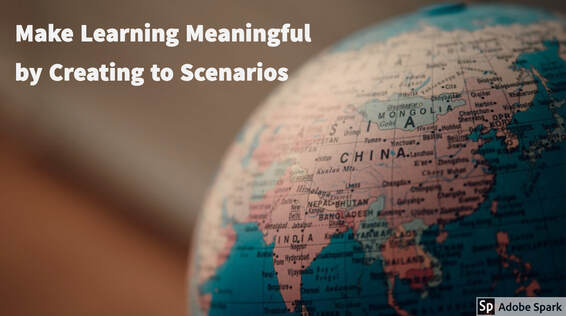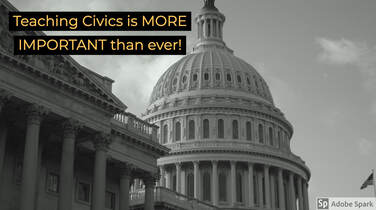|
Student creation is about more than just creating to create. You should want to create for a purpose. You should want to create for understanding and meaning. You should want to create to make the world a better place, and it all starts by building a scenario for the creation. Scenarios should always be your starting place.
What do I mean by that? I see student projects all the time that are “just create something about the topic.” That topic could be anything, but what the teacher is going to get is always the same: bad power points and bad videos. What if you actually made them create for an audience? What if you made them solve a real-world problem? You could get more than just bad tech tools with regurgitated information. To me, this takes me back to my days in the Social Studies classroom. In Social Studies, it’s so easy to fall into the trap of just having kids do a presentation to regurgitate information You have seen them a million times. They tend to have bad backgrounds, arguably plagiarized text, and images that just look weird. I thought there had to be more, and what I came to is that there had to be a scenario to create to. Instead of just giving them a topic, I gave them an audience. I put them in the history. They had to critically think like the people they were studying and like they were there. Does this sound hard? Well, it isn’t. There are thousands of scenarios you could use in any topic, but I found one that was always a good starting place if I got stuck: The United Nations. Think about it, they have a hand in everything. They work with plenty of data to tie math in. They are worried about the planet which ties in Science, and they are involved in politics which ties in Social Studies. With ELA, you can adapt grammar and writing projects to almost anything. It means you can have all four CORE subjects covered in one audience. The UN has even made it easier. They have published a set of 17 goals that they have for the planet by 2030. These are a great starting place! It sums up the world's problems beautifully and gives you a great place for kids to start solving them. There is also a massive teaching community around them, so you don’t even have to create all of the activities yourself! These can even be used for coding scenarios, and Tynker has done just that. Check out the Hour of Code projects based on the SDG's at https://www.tynker.com/hour-of-code/
1 Comment
Let's take a few minutes to talk about my new favorite maker tool. It's got the two things that I think are the ultimate keys: accessibility and high ceiling. It's cheap, and you can code it in both Block and Python. What device is it? It’s micro:bit.
This device is the little mini-computer that could! A micro:bit has several aspects to it including an LED panel you can code, buttons, sensors, and edge connectors that can be used to add things like lights and motors. You can create your own robots, games, and even a scientific instrument or two. The ceiling is incredibly high because it can be the brains for almost anything! It’s also an incredible way to learn coding. Kids can build and create anything, and they get to program it to do the function that they want. The coding on the device is also incredibly accessible. With both block coding resources and Python resources, you can have elementary school students make with it, but you can also take it into high school with Python. There aren’t that many devices that can cross over like that I am fortunate to work with a company that even takes that micro:bit accessibility a step further. Sometimes it’s hard to teach kids everything they need for a mini-computer. You might want them to create, but you might not know where to start. Tynker has courses to fix that problem. We have both a micro:bit block course and a Micropython course that teach kids all the aspects of the micro:bit. They build projects to learn how to use the sensors, led’s, buttons, and edge connectors with the goal being to learn the functions well enough to build their own project. We have even simplified code deployment to make it easy no matter what device you have. What can you build? The possibilities are endless. You could build robots, rc cars, scientific instruments, and much, much more. The ability to add accessories with the edge connector ensures that you can build almost anything you want. Isn't that what making is all about? This blog is for my friend the Social Studies teacher. Many times your the red-headed stepchild of the core content group, but if we can take anything from the current state of affairs, you are so important. You might be the last ones to get new standards, but you are going to be the first ones that kids actually use coming straight out of high school.
This isn't to say the others aren't important, but think of the first ways someone can participate in the greater society. It's things like registering to vote, registering for selective service, and getting into the federal student loans program. All of them are things that may need advocacy, and we have to teach our students to advocate and participate. No matter what you believe with the current state of the US government the abundantly clear thing is that we need to do an even better job of teaching civics. The impeachment inquiry is s a perfect example of this. It's clear that many Americans don't fully understand that process, and that lack of understanding is helping both sides manipulate both the process and messaging with it. We are constantly hearing a lot about the process. The thing to understand though is that the process right now is like a grand jury. It's about finding enough evidence to see if you can take it to trial, but because it's already being tried in the public conscious people think that things should look like a full trial. That's the not the way things are laid out in the constitution, yet many Americans don't realize that. It allows both sides to manipulate the message to benefit their point of view. We hear the argument of fake news and bias all the time. In reality, it's there on both sides of the argument. The problem we are all having is that we aren't teaching civics well enough which makes it almost impossible for folks to decipher what is real and fake. We have to keep up that fight because in an age of endless media, knowing civics is the only thing that will let you know what is real and true. We are getting to a point where teaching civics is going to be the only thing that saves us. The old saying ignorance is bliss does not apply here. If you don't know how things work you just can't decipher through the noise. Civics Teachers: Keep up the fight! You don't know how important you are! |
Archives
January 2023
Categories |




 RSS Feed
RSS Feed
